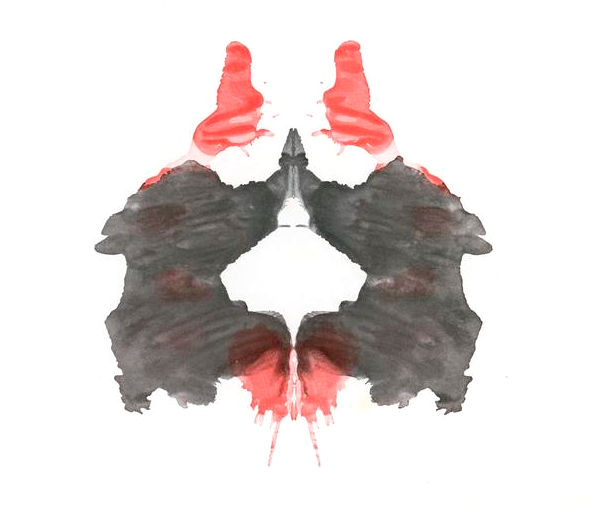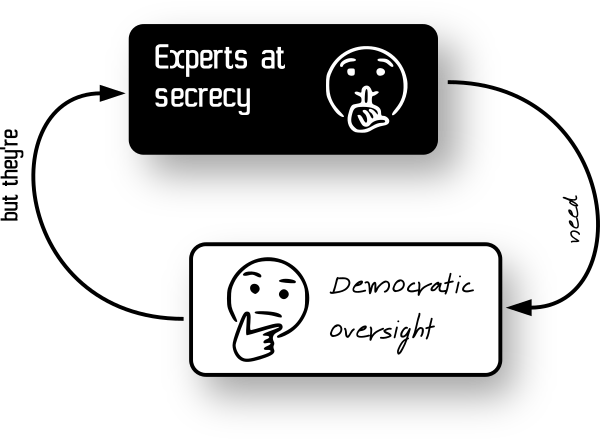Conspiracy theories and theories of conspiracy
“Even a paranoid can have enemies.” - Henry Kissinger (unsubstantiated).

Warning: Conspiracy theories ahead! Brace for DEFCON 9.
In evolutionary physiology, it pays to err on the side of caution. Or is the correct phrase “better to be safe than sorry”? If you kept ignoring the stirrings in the grass, a sabre-tooth tiger would eat you. If you keep cleaning your shotgun whilst it’s loaded, you’re bound to lose an ear. Given the hugely important role of cryptography, could we thus say, in cryptography, it pays to err on the side of caution? If you blindly trust all TRNGs to be truly random, you might get be-fooled, robbed or dead.
Take the following image as an example of the ease of conspiracy ideation. If you don’t immediately see two persons in red hats huddled either side of a table (conspiring together), there is something psychologically worth investigating:-

Two persons in red hats huddled either side of a table, (conspiring together).
That’s just a so-called cognitive bias in error management and apophenia, both basic (and natural) Darwinistic protective behaviours.
But, historical evidence and sensational revelations like Snowden’s continue to astonish us with what the security services and governments conjure up. Actual conspiracies occur quite regularly. Political assassinations, scandals and cover-ups, terrorist attacks and a lot of everyday government activity involves the collusion of multiple people in the attempt to bring about a desired outcome. The sheer creativity and perverse imagination is both stunning and chilling. That includes the corporations too. It’s a cheap cliché, but we all know beyond reasonable doubt that sometimes, They have been out to get you.
Can our intellect trump our animal instincts to hypothesise conspiracy, and to identify and characterise semi-random events as patterns of malevolent force and actors trying to hurt us? The Gestalt school teaches that it can’t. Can we then logically and impartially differentiate between conspiracy theories and theories of conspiracy? By what quantitative measures can we decide when one has evolved into the other? And how can we navigate immensely resourced and highly organised waves of (dis)information published via multiple channels, in order to make that judgement?
The simple/correct/depressing answer is that you can’t. And we at REALLYREALLYRANDOM.COM can’t, either because we just don’t know or can’t find out. In 2018, the US spent $81.5B on its national & military intelligence programs. That was approximately 47% of that year’s entire NHS England health spend. 2019’s current budget appropriation was similar. Other countries spent further money on their equivalent programs. Where do all those vast multi-hospital sized sums go every year? How many people and corporations are on the receiving end? How are a few crowd sourced articles on Wikipedia to compete on transparency concerning so-called ‘national security’ matters?

The Catch-22 preventing democratic oversight of the intelligence community.
The Catch-22 facing the conspiracy theorist, intelligent sceptic and faithful believer is this - If secrecy is your core business and you’re good at it, how can there possibly be effective democratic oversight if secrecy is your core business and you’re good at it? And unhelpfully, all national security agencies are exempt from Freedom of Information laws. As our collective Id fights with our collective Ego to make sense of it all, we fail dismally and just become more neurotic and paranoid than Eve… Wait! Did you hear that?
Before you panic/laugh and/or flee this site wondering what on Earth this has this to do with entropy and TRNGs, read on…
You can only prove that any given sequence is computationally indistinguishable from a random sequence. You cannot prove that it is Kolmogorov random, and yet that is thee fundamental requirement for any TRNG. Given the ever increasing myriad confirmed/highly suspected conspiracies, tradecraft and the virtual impossibility of successful device audit, how do we know that commercial TRNG’s are truly random? Are the numbers emerging from that little black box totally secure even if they ace Dieharder? Might there have been skulduggery afoot?


Notes:-
[1] The National Intelligence Strategy of the United States of America 2019 is an unremarkable but interesting read, especially the side panels. If true. It probably is.
[2] But GCHQ’s The Art of Deception, Training For A New Generation Of Online Covert Operations presentation is super fascinating, showing how far They routinely go. We have job application forms if you want them.